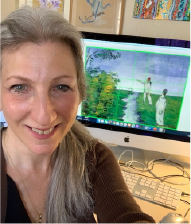Computer-Assisted Analyses of Digitized Fine Art: Cézanne and His Sources
Quantitative analysis using dendrography is a new methodology being utilized in art history to study relationships between digitized fine art paintings. Using dendrography, we can now challenge conventional narratives concerning the origin and development of an artist’s style. We can test hypotheses regarding potential relationships between paintings and sources. We can find internal similarities and consistencies between groups of paintings heretofore not considered. The challenge with this kind of analysis is that results may vary dependent on the parameter being measured. Also, the quality of the digital images being measured can affect the results. In this webinar, Dr. Melinda Weinstein, Research Fellow at the W.M. Keck Dynamic Image Analysis Facility at the University of Iowa, discusses her application of dendrography to the study of the digitized oil paintings of Paul Cézanne. For a preview of her work see “Dendrography and Art History: A Computer-Assisted Analysis of Cézanne’s Bathers.”
Participants will learn how to integrate computer-assisted methods into formal art analysis; how to responsibly source images from the web for computer-assisted analysis; the importance of the central axis, and phi, as determined by the rectangular shape of the canvas, to the composition of Cezanne’s paintings, regardless of genre; and how Cézanne absorbed and recapitulated the color combinations of Delacroix, Gérard and David in select works.
Presenters
 Dr. Melinda Weinstein is a Research Fellow at the W.M. Keck Dynamic Image Analysis Facility at the University of Iowa. Her work on Cézanne bridges the philosophy of mathematics, computer science, and fine art.
Dr. Melinda Weinstein is a Research Fellow at the W.M. Keck Dynamic Image Analysis Facility at the University of Iowa. Her work on Cézanne bridges the philosophy of mathematics, computer science, and fine art.
